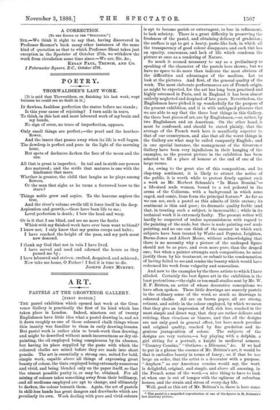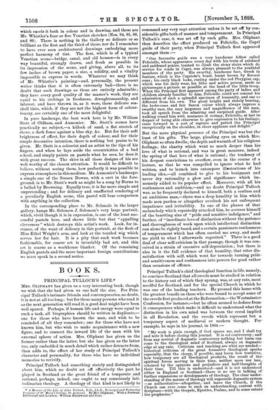ART.
PASTELS AT THE GROSVENOR GALLERY.
[FIRST NOTICE.]
'THE pastel exhibition which opened last week at the Gros- venor Gallery is practically the first of its kind which has taken place in London. Indeed, nineteen out of twenty Englishmen have little idea what a pastel drawing is, and set it down roughly as one of those coloured chalk things whose thin inanity was familiar to them in early drawing-lessons. But pastel work is rather akin to brush-work than drawing, and might be described without much incorrectness as dry oil- painting, the oil employed being conspicuous by its absence, but having its place supplied by the paste with which the coloured chalks are mixed before they are made into short pencils. The art is essentially a strong one, salted for bold, simple work, capable above all things of expressing great beauty of colour, the tints employed being extremely numerous and vivid, and being blended only on the paper itself, so that the utmost possible purity is, or may be, obtained. For all miring of colours takes something away from their brilliancy, -and all mediums employed are apt to change, and ultimately to darken, the colour beneath them. Again, the art of pastels in skill-less hands has great dangers and drawbacks which are peculiarly its own. Work dealing with pure and vivid colours is apt to become garish or extravagant, to lose in refinement, to lack sobriety. There is a great difficulty in preserving the freshness of the pastel, and obtaining delicacy of gradation ; the surface is apt to get a heavy, paste-like look, in which all the transparency of good colour disappears, and each tint has an opacity, coarseness, and lack of life which condemn the picture at once as a rendering of Nature.
So much it seemed necessary to say as a preliminary to speaking of the character of the pastels here shown ; but we have no space to do more than indicate the most obvious of the difficulties and advantages of the medium. Let us look at the pictures. And first, of the general quality of the work. The most elaborate performances are of French origin, as might be expected, for the art has long been practised and highly esteemed in Paris, and in England it has been almost entirely neglected and despised of late years. Nevertheless, the Englishmen have picked it up wonderfully for the purpose of the present exhibition, and it is with unfeigned pleasure that we are able to say that the three best things in this Gallery, the three best pieces of art, are by Englishmen,—or, rather, by two Englishmen and an American. On the other hand, it must be confessed, and should be stated plainly, that the average of the French work here is manifestly superior to that of our countrymen, and also that all the worst things in the Gallery are what may be called rampantly English ; and in one special instance, the management of the Grosvenor Gallery have been very injudicious in their hanging of the examples, as the poorest picture in the exhibition has been , selected to fill a place of honour at the end of one of the large rooms.
As, owing to the great size of this composition, and its clap-trap sentiment, it is likely to attract the notice of the public, it is worth while to protest firmly against such a work as Mr. Herbert Schmalz's " In Manu Domini,"— a life-sized nude woman, bound to a red pedestal in the arena of the Coliseum, with a background in which some caged, and comic, lions form the principal feature.* As far as we can see, such a pastel as this admits of little excuse; its sentiment is thin and poor ; its dramatic quality feeble (and that, in treating such a subject, is inexcusable) ; while in its technical work it is extremely faulty. The present writer will hardly be suspected of undue squeamishness with regard to the painting of the nude, but there is nude painting and nude painting, and no one can think of the manner in which such subjects have been treated by Watts and Poynter, Leighton, Burne-Jones and Albert Moore, without acknowledging that there is no necessity why a picture of the undraped figure should not be as pure, and even more pure, than the draped one; but when a painter attempts such compositions, he must justify them by his treatment, or submit to the condemnation of having failed to see and render the beauty which would have redeemed his work from vulgarity and sensualism.
And now to the examples by the three artists to which I have alluded. Certainly the best figure art in the exhibition is the least pretentious,—the eight or ten small studies sent by Mr. W. E. F. Britten, an artist of whose decorative conceptions we have often spoken. These little drawings are scarcely pastels in the ordinary sense of the word, so much as drawings in coloured chalks. All are on brown paper, all are strong, reticent, and subtle in the colour employed, by which we mean that they give an impression of full, rich hue, reached in the most simple and direct way, that they are rather delicate and retiring, than vivacious or bizarre, and that all the designs are not only good in general effect, but have much peculiar and original quality, reached by fine gradation and in- genious juxtaposition of colour. The subjects of the designs are very various,—a boy playing with a dolphin, a girl sitting for a portrait, a knight in medimval armour, " Country Cousins," " Outlaws : a Dilemma," &c. If we had to put in a phrase the essence of Mr. Britten's art, it would be that it embodies beauty in terms of fancy ; or, if that be too large an order, that the artist is a decorator with a purpose. "Anyhow," as our American cousins would say, the work is delightful, original, and simple, and above all amusing, in the French sense of the word,—a nice thing to have to look at when one is out of temper with the ugliness of suburban houses, and the strain and stress of every-day life.
Well, good as this art of Mr. Britten's is, there is here some
* This pastel is a magnified reproduction of one of the figures in H. Schmalz's last Academy picture.
which excels it both in colour and in drawing, and these are Mr. Whistler's four or five Venetian sketches (Nos. 84, 85, 88, and 89). There is nothing in the Gallery so delicate or so
brilliant as the first and the third of these, nor do I remember to have ever seen architectural drawings embodying more
perfect harmony of tint. The first, which is of a typical Venetian scene—bridge, canal, and old houses—is in every way beautiful, strongly drawn, and fresh as possible in its impression of the scene, and giving, above all, to its
few inches of brown paper, a size, a solidity, and a vitality impossible to express in words. Whatever we may think
of Mr. Whistler's painting—and, personally, the present writer thinks that it is often extremely bad—there is no doubt that such drawings as these are entirely admirable ; they have every good quality of the master's work, they are equal to his etchings in freshness, draughtsmanship, and interest, and have thrown in, as it were, these delicate sea- shell tints, which, if they are not the highest form of colour- beauty, are certainly one of the most delightful.
In pure landscape, the best work here is by Mr. William Stott of Oldham, and Aumonier. Mr. Stott's scenes have practically no subject,—a hillock of sand, a fiat stretch of shore, a dark fence against a blue sky, &c. But for their soft brightness of effect, for their depth of colour, and for their simple decorative intention, there is nothing but praise to be given. Mr. Stott is a colourist and an artist to the tips of his fingers, and when he lays aside the eccentricities of a bad szhool, and simply paints on pastels what he sees, he does it with great success. The skies in all these designs of his are well worthy of the closest attention. It would be difficult to believe, without seeing them, how perfectly it was possible to express atmosphere in this medium. Mr. Aumonier's landscapes a simple one of the Sussex Downs, with a cart in the fore- ground, is to Mr. Stott's work as might be a song by Burns to a ballad by Browning. Equally true, it is far more simple and unpretending ; and for delicacy and unaffected rendering of a peculiarly English scene, this pastel will bear comparison with anything in the collection.
In the corresponding place to Mr. Schmalz in the larger gallery, hangs Mr. Solomon J. Solomon's very large portrait, which, vivid though it is in expression, is one of the least suc- cessful pastels here, and shows little but that "appalling cleverness " which destroys this artist's work. Look, for in- stance, of the want of delicacy in this portrait, at the flesh of Miss Ethel Wright's arm, and look at the touzled wig which serves her for hair. It is a pity that such work becomes fashionable, for coarse art is invariably bad art, and this art is coarse as a workhouse blanket. Of the remaining English pastels and the more important foreign contributions we must speak in a second notice.



















































 Previous page
Previous page